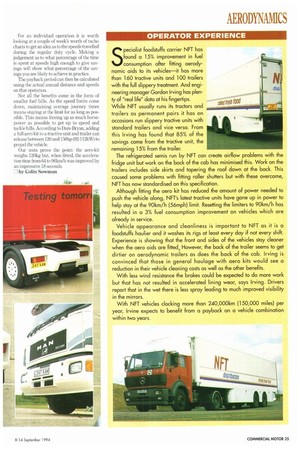OPE RATOR EXPERIENCE
Page 37

If you've noticed an error in this article please click here to report it so we can fix it.
Specialist foodstuffs carrier NFT has found a 15% improvement in fuel consumption after fitting aerodynamic aids to its vehicles—it has more than 160 tractive units and 100 trailers with the full slippery treatment. And engineering manager Gordon Irving has plenty of "real life" data at his fingertips. While NFT usually runs its tractors and trailers as permanent pairs it has on occasions run slippery tractive units with standard trailers and vice versa. From this Irving has found that 85% of the savings come from the tractive unit, the remaining 15% from the trailer The refrigerated semis run by NFT can create airflow problems with the fridge unit but work on the back of the cab has minimised this. Work on the trailers includes side skirts and tapering the roof down at the back. This caused some problems with fitting roller shutters but with these overcome, NFT has now standardised on this specification.
Although fitting the aero kit has reduced the amount of power needed to push the vehicle along, NFT's latest tractive units have gone up in power to help stay at the 90km/h (56mph) limit. Resetting the limiters to 90km/h has resulted in a 3% fuel consumption improvement on vehicles which are already in service.
Vehicle appearance and cleanliness is important to NFT as it is a foodstuffs haulier and it washes its rigs at least every day if not every shift. Experience is showing that the front and sides of the vehicles stay cleaner when the aero aids are fitted; However, the back of the trailer seems to get dirtier on aerodynamic trailers as does the back of the cab. Irving is convinced that those in general haulage with aero kits would see a reduction in their vehicle cleaning costs as well as the other benefits.
With less wind resistance the brakes could be expected to do more work but that has not resulted in accelerated lining wear, says Irving. Drivers report that in the wet there is less spray leading to much improved visibility in the mirrors.
With NFT vehicles clocking more than 240,000km (150,000 miles) per year, Irvine expects to benefit from a payback on a vehicle combination within two years.




























































































